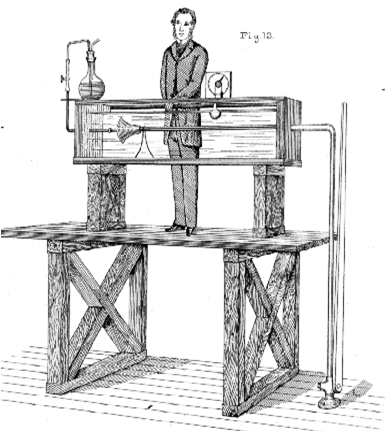0.2.6.
Reynolds Number and Laminar Flow
Osborne Reynolds studied motion of water in long straight smooth tubes, in order to find out critical flow velocity, at which the laminar flow was disturbed by “birth of eddies”. The essence of his immaculate research is an equation that carries his name:

where Re is Reynolds number, is density is mean flow velocity and is viscosity. The Reynolds number captures a balance between transport forces and viscous forces. For Re > 2000 turbulent flow prevails and for Re, < 1000 laminar flow conditions exist in a pipe, at which condition the only means of mass transfer in radial direction is diffusion. Since for a typical FIA system Re is 10 to 150 and therefore according to theory, the diameter of FIA channel has to be downscaled To 50mm and the flow rate slowed down to 10microliter/min in order to allow the

The apparatus based on gravity driven flow, used by O. Reynolds to study laminar flow in pipes.
slow rate of diffusion promote the radial dispersion sufficiently to alter the shape of the moving bolus from a bullet shape to a “rolling ball” shape. This is the soncept on which lab-on-chip and microTAS devices are based.
Yet, reading Reynolds works (Reynolds 1883) reveals, that 1/ dimensions of his apparatus and the conditions of his experiment, were far different from conditions at which FIA techniques operate. His pipes were absolutely straight and ranged from 6 to 500 mm I.D. with lengths between 3 to 5 m. Reynolds flow was stabilized as he took extreme precautions to avoid any flow fluctuations 2/ Reynolds intensions were to establish the maximum flow rate, at which the laminar flow rate can be sustained 3/ he demonstrated that an obstacle placed in the pipe will induce turbulent flow at far lower Re values.
Therefore it is misleading to assume that FIA system operate at laminar flow conditions. What makes FIA techniques feasible is the channel design, where at T points turbulent flow exists, the changes of flow rates and direction controlled by flow programming that purposely break up the laminar flow pattern, with the aim to promote radial mixing.









